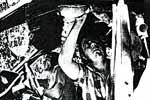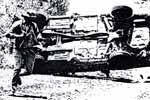
 |
|
Navigation links at
the bottom of the page
|
| EAST AFRICA SAFARI RALLY | |||||
| It
is the toughest road test in the world: 3100 miles of corrugated machine-killing
bush road varying in elevation from sea level to 7000 feet. It rattles
race cars to destruction and grinds their drivers and navigators to
shivering abstraction. It is a test run from which the successful are
not merely finishers, but survivors. It is the East African Safari
Rally.
Even compared to the standard-issue World Championship rally, the Safari course is a tough, grueLling and arduous course. In most other rallies, there are fast, bald highways between the rough "special sections," but the East African Safari course in Kenya is one long, 3100-mile special section. There is no respite from the grind, and the 1976 event – the 24th running – was no different from the notorious norm. The 1976 East African Safari was run in the rainy season, which transformed normally treacherous roads into quagmires booby-trapped with unseen and terrifying hazards. In the 1968 rally, the complete field got bogged down on the Mau escarpment and only seven – dubbed the "unsinkable seven" – cars made it back to Nairobi. The same thing happened in 1974 to David Green and Terry Pilford, two ralliers who typify Safari challengers. David Green, 29, short, stocky and muscular, is a third-generation tea planter from the rolling Limuru Hills north of Nairobi. Terry Pilford, 37, tall, lithe and grey-haired, is an English engineer with a laconic sense of humor. "It's grit, spit and you know what," he said when asked why he spends his time in rally cars. "It's a taste in your mouth that won't go away. The French call it le chase." |
|||||
For Pilford, Green and their friends, ordinary people mostly with ordinary jobs, rallying is a sport in which everyone can join. For minor rallies everyone took part driving his own car. but for major events they combined forces to provide reconnaissance crews, mechanics and service work, for the Safari Rally they knew there would he tough competition from the professional works teams so everyone pitched in to help. Pilford and Green bought a standard works Datsun 1600 SSS in January and took it to Green's Coonoote Farm near Limuru to convert it to "rally standard." |
 |
||||
| Pilford and Green prepping their Datsun | |||||
"It's grit, spit and you know what," he said when asked why he spends his time in rally cars. "It's a taste in your mouth that won't go away. The French call it Ie chase." For Pilford, Green and their friends, ordinary people mostly with ordinary jobs, rallying is a sport in which everyone can join. For minor rallies everyone took part driving his own car. but for major events they combined forces to provide reconnaissance crews, mechanics and service work, for the Safari Rally they knew there would he tough competition from the professional works teams so everyone pitched in to help. Pilford and Green bought a standard works Datsun 1600 SSS in January and took it to Green's Coonoote Farm near Limuru to convert it to "rally standard." A high-compression ratio engine complete with skid pan, twin double-choke carburettors, banana-exhaust manifolds and a large capacity sump were all fitted during long nights and weekends. A special five-speed gearbox was added, along with HD shocks, extra-large fuel tank, M&S tires, roll bars, surface radiator, rally instruments and ventilated disc brakes. The total bill? About $10,000. But even with that kind of investment, no one underestimated the competition when the works teams from Europe and Japan began to arrive in February. There was also Joginder Singh, the Flying Sikh of Kenya, to he reckoned with. Joginder, a Nairobi businessman, confounded the experts in '74 and '75 by winning the Rally both years by a large margin. He was out to win for the third time and make Safari history. In short, the odds were against the Pilford team but from the viewpoint of guts, stamina and enthusiasm they were already ahead of the field. There were still enormous problems to overcome, however. They had to run-in and tune the rally engine without sophisticated electronic test equipment. Everyone gathered for the start-up the first weekend in March and had a dispiriting two hours, waiting for the experts to get the engine going. When it finally fired there was a great cheer and wide grins from the mechanics, Wilf and Andy. They gently cranked it up to 3000 rpm but it was very rough. "They don't really run smoothly until they reach 4000 revs," Green explained. Pilford was more explicit. "These high-performance engines are marvellous at ten thousand feet." he said. "but bloody useless at sea level." The state of the gearbox turned out to be another major problem. Draining it for an oil change in the hot African sun, they found steel filings in the oil. It meant they had to remove and strip the box to check the damage, and then there was the problem of tracking down replacement parts in East Africa. Except for the second gear, the box was synchromesh: metal had been torn off the second gears. Making repairs took time which, with the arrival of late March, was precious. The whole team – engineers, salesmen, a secretary, wives and girl friends – was soon involved in a frantic race to finish its preparations. Not the least of these was an extensive survey of the route. Had Pilford and Green been part of a works team they could have driven the complete circuit at their leisure with the help of professional reconnaissance crews and even a helicopter to check the course. Teams were sent out each weekend to check the terrain on each of the three legs chosen by the route organizers. Of the three selected, one reached Mombasa a on the coast, the second went as far as Kisumu on the Uganda border and the third swung through the barren semi-desert of the Lake Turkana District of Kenya's northern territories. The rally course had everything: thorn-tree studded game country with elephant, lion, leopard and giraffe as added unpredictable hazards to drivers. No obstacle, however, was as unpredictable as the local Africans to be encountered along the way. Stone-throwing at competitors had risen to dangerous proportions over the years (more from exuberance than malice) and serious accidents had occurred. However, when the day of the start arrived – April 15 – Pilford and Green were as ready for the fray as ever they would be. The 24th Safari Rally began at 4 p.m. in the city center of Nairobi that day with an immense crowd of spectators as colorful as an African street market in attendance. Kenya's President Kenyatta flagged away the first of the field, which was followed by the screaming cars of Joginder Singh, Japan's Kenjiru Shinozuka, Bert Shankland of Tanzania, Sweden's Harry Kallstrom in a Datsun 710, Jean Nicolas of France in a Peugeot, and Kenya's John Hellier in an Alfa Romeo. Pilford and Green, as leaders in the second seeding from the '75 event, won 18th position in the line-up. There were 64 entries in all, so the Pilford-Green team was placed in a comfortable position. Whipping along the Mombasa road to the first checkpoint at Kajiado, David hit an easy 100 mph. Visibility was good despite a sky heavily overcast and he was soon on the tail of the car ahead. The road to Kajiado is flat, dusty and easy to travel but from there the course criss-crossed the main highway through the first hilly, difficult terrain. Though it was early in the race, Green took no chances. Mindful of rock throwers, he eased off the throttle when passing spectators along the way, then gunned the Datsun to put any stoners off their stroke. Slipping out of Kajiado along the first stretch of bush road they actually managed to pass a couple of early drop-outs stuck with mechanical failures. Terry kept a sharp lookout for obstacles, but there were so few incidents they began congratulating themselves on the way things were going for them. By 7 p.m., somewhere between checkpoints 3 and 4, with the onset of nightfall, they felt there was no longer any danger from rock throwers. |
|||||
| At
Kalii. checkpoint 4, they learned from officials they were making good
time and, in fact, gaining slightly on the field. The country around
Kalii is hilly with dense brush, dry most of the year but as treacherous
as a quagmire in the rainy season when the washboard roads turn to
grease tracks and gullies swell to raging torrents. Though the road
was a little greasy from rain earlier it was in reasonable condition
for them to make a fast run to the next checkpoint. Kitui.
The Datsun was performing beautifully and they were in high spirits. Assessing their chances at this point in the race, what hope did they have? |
 |
||||
| For those who think rallying an effete sport, there's always a graphic argument | |||||
The entries were down considerably from previous years; many top ralliers were missing from this year's event; and the Pilford-Green team was in top form. Blasting along the Kitui road. clawing up stones around each hairpin bend, bouncing over hillocks, they really felt they stood a good chance of gaining one of the top positions.What took place during the next few moments happened so quickly they later had difficulty recalling exactly what did occur. . . and is typical of the Safari's nature. David had brought the Datsun out of a tight turn, then slid, did a slow turn, and slipped disastrously into a ditch. They were out of the race. Damned bad luck. It happens to the best, but as Pilford said, they could look forward to next year's rally. Road TestSeptember 1976 |
|||||
|
|||||